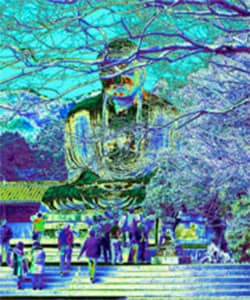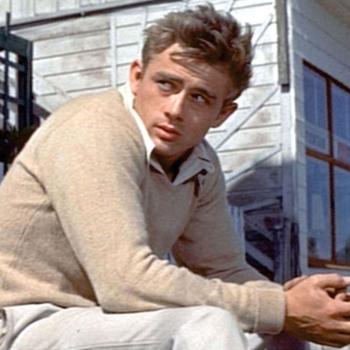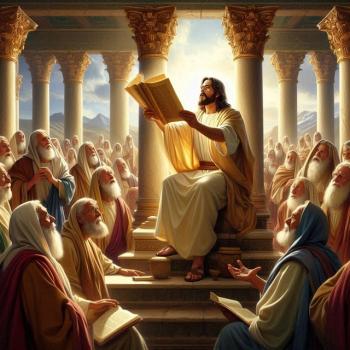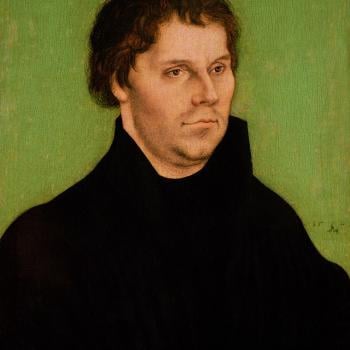Editors' Note: This article is part of the Patheos Public Square on Religion and Visual Art. Read other perspectives here.
One of my favorite things in the world is the thirty-foot-high bronze Buddha statue known as the Daibutsu (literally, "Big Buddha" or "Great Buddha") in Kamakura, a small city located in the hills outside Tokyo.
 |
| Zazen Ultraman ©Tom Swiss |
There's another ancient bronze Daibutsu in Nara, near Kyoto; and while Nara's Daibutsu is both older and larger — and the regional pride I soaked up during the months I lived in Osaka means I usually favor the Kansai region (Osaka, Kyoto, Kobe, Nara) in its longtime rivalry with Kanto (Tokyo, Yokohama, Kamakura) — I have to give the edge to the Kamakura Daibutsu because of its outdoor location.
This is one of those art-by-accident things: over five hundred years ago a tsunami destroyed the temple buildings but was unable to do much to the 120-ton statue itself. So Kamakura's Great Buddha sits in the open air, wooded hills for a backdrop, immovable in his centuries-long meditation, undisturbed by the fury of the elements.
The early Buddhists would be shocked by both of these giant Buddhas, or indeed by any statue of their teacher. (For purposes of this discussion I'm going to punt on the distinction between the historical Shakyamuni Buddha and the various cosmological Buddhas of later Buddhism.) For the first few centuries of Buddhism, artists rarely if ever created depictions of their main holy man, instead using symbols such as an empty throne or footprints marked with the "Wheel of the Law." There seems to have been a sort of anti-idolatry philosophy in effect, either formally or informally. (The practice of making statues of the Buddha was probably adopted later from the Greeks when the remnants of the Hellenistic empire of Alexander met the expanding Indian Buddhist culture of the emperor Ashoka. See Fields, pp. 14-16.)
There's a certain sense to that anti-idolatry. A famous Buddhist analogy (popularized by a Bruce Lee monologue in Enter the Dragon) speaks of teachings as a finger pointing to the moon, and the importance of not focusing on the finger. If religious art is to be a pointer to a religious experience, it must not be too captivating, must not tempt the viewer's eye to stick on the finger rather than continuing on to the moon.
The same idea is likely at the root of the Islamic prohibition on images of Muhammad that has caused such trouble recently. It is entirely reasonable for Muslim teachers to be concerned about people focusing on the messenger and not the message, and even to discourage artistic depictions of their Prophet as a means to keep a check on idolatrous tendencies to miss the moon for the sake of the finger.
Now, when I say there's a reasonable concern, I don't mean I agree with a ban. Yes, there is a potential pitfall of mistaking the map for the territory, of setting the bottle of medicine up on a pedestal for admiration rather than taking the stuff. But to turn "there is a hazard here, beware" into "there is sure damnation here, woe unto thee!" is an error — perhaps one of the most common in the field of religion — creating a black-and-white, Manichean morality.
And to then turn that religious teaching into a civil law, enforced by the sword or the gun, is a grave sin, going far wide of the mark.
It's a shame not just because it results in people being ostracized, caged, beaten, or killed, but because it limits the tools that we have available to create religious experiences.
In his magnum opus The Meeting of East and West, F.S.C. Northrop wrote about two distinct functions of art and how they match up with two separate components of the nature of things. Our experience has a theoretical component, and one function of art is to convey aspects of that theory via analogy and symbolism. This was how the majority of Western art, particularly religious art, worked prior to the 19th-century Impressionist movement. But our experience also has an aesthetic component, immediately and empirically given, and art can be an experience of this component for its own sake. (See Northrop, pp. 303-306.)
 |
| Creation of Adam, Michelangelo (public domain) |




